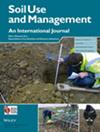添加生物炭对咸水灌溉下沿海盐碱土中水盐分布和冬小麦生长的影响
IF 3.7
3区 农林科学
Q1 SOIL SCIENCE
引用次数: 0
摘要
为研究适合黄河三角洲地区盐碱土的节水增产改良方案,本研究以当地中度盐碱土为研究对象,进行了室外盆栽试验。主要重点是研究在咸水灌溉条件下,添加生物炭对盐碱土中水分和盐分分布的影响及其对冬小麦生长的影响。在研究过程中,研究设计了三种不同的灌溉水矿物质浓度(0、2 和 4 g L-1)。研究中使用了两种生物炭,即小麦秸秆生物炭(WB)和玉米秸秆生物炭(CB),并采用了四种不同的施用量(0、5、10 和 20 吨/公顷)。共有 21 个处理,每个处理重复三次。这些研究结果表明,咸水灌溉和生物炭的施用显著提高了土壤含水量(SWC),各处理的土壤含水量提高了 12.8% 至 83.9%。使用咸水灌溉会增加土壤含盐量(SSC),加剧土壤盐碱化。然而,施用生物炭可以降低土壤盐度,减轻盐碱化程度,从而抵消这种影响。施用生物炭的处理大多会增加 SSC,但适当施用生物炭有降低盐分的作用,可使 SSC 降低 15.2%。生物炭还降低了土壤钠吸附率(SAR)和可交换钠百分比(ESP),减轻了高盐度对冬小麦的不利影响。最后,施用生物炭促进了冬小麦的生长并提高了产量,在咸水灌溉条件下,施用 10 吨/公顷生物炭的处理(K2Y10)产量最高,比未施用生物炭的处理(CK0)增产 18%。总之,从节水、减盐和增产三方面考虑,该地区最有效的盐碱地改良方案是在使用 2 g L-1 苦咸水灌溉的同时施用 K2Y10。这种方法兼顾了解决土壤盐碱化、加强节水和最大限度提高作物产量。本文章由计算机程序翻译,如有差异,请以英文原文为准。
Effect of biochar addition on water–salt distribution and growth of winter wheat in coastal saline-alkali soils under brackish water irrigation
To investigate water-saving and yield-enhancing improvement programmes suitable for saline-alkali soils in the Yellow River Delta region, this study conducted outdoor pot experiments utilizing local moderately saline-alkali soils as research subjects. The primary focus was to examine the impact of biochar addition on water and salt distribution in saline-alkali soils and its effect on winter wheat growth under brackish water irrigation conditions. The study design established three different irrigation water mineral concentrations (0, 2 and 4 g L−1) during the research. Two types of biochar, wheat straw biochar (WB) and corn straw biochar (CB), were used with four different applications (0, 5, 10 and 20 t ha−1). There were 21 treatments; each replicated three times. These findings demonstrated that brackish water irrigation and biochar application contributed to a notable increase in soil water content (SWC), with increases ranging from 12.8 to 83.9% across treatments. Using brackish water for irrigation increases soil salt content (SSC) and exacerbates soil salinization. However, the application of biochar counteracts this effect by reducing soil salinity and mitigating the degree of salinization. Treatments applying biochar mostly increased SSC, but proper application had a salinity-reducing effect, reducing SSC by up to 15.2%. And biochar reduced the soil sodium adsorption ratio (SAR) and exchangeable sodium percentage (ESP), mitigating the adverse effects of high salinity on winter wheat. Finally, the application of biochar promoted the growth of winter wheat and increased yield, with the treatment applying 10 t ha−1 of CB (K2Y10) producing the greatest yield under brackish water irrigation conditions and increased by 18% compared with the treatment without biochar (CK0). In summary, considering the aspects of water conservation, salt reduction and yield increase, the most effective saline land improvement programme for this region involved using 2 g L−1 brackish water for irrigation in combination with applying K2Y10. This approach balances addressing soil salinity, enhancing water conservation and maximizing crop yields.
求助全文
通过发布文献求助,成功后即可免费获取论文全文。
去求助
来源期刊

Soil Use and Management
农林科学-土壤科学
CiteScore
7.70
自引率
13.20%
发文量
78
审稿时长
3 months
期刊介绍:
Soil Use and Management publishes in soil science, earth and environmental science, agricultural science, and engineering fields. The submitted papers should consider the underlying mechanisms governing the natural and anthropogenic processes which affect soil systems, and should inform policy makers and/or practitioners on the sustainable use and management of soil resources. Interdisciplinary studies, e.g. linking soil with climate change, biodiversity, global health, and the UN’s sustainable development goals, with strong novelty, wide implications, and unexpected outcomes are welcomed.
 求助内容:
求助内容: 应助结果提醒方式:
应助结果提醒方式:


